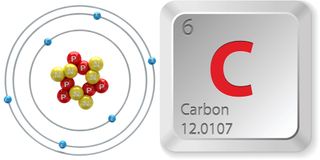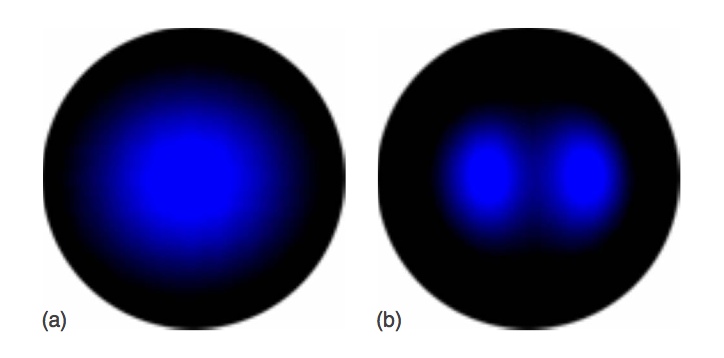Facts About the Carbon Family on the Periodic Table
Facts About Carbon

Carbon is an incredible element. Arrange carbon atoms in 1 way, and they get soft, pliable graphite. Re-jigger the arrangement, and — presto! — the atoms form diamond, one of the hardest materials in the world.
Carbon is as well the key ingredient for most life on Earth; the paint that fabricated the outset tattoos; and the ground for technological marvels such as graphene, which is a material stronger than steel and more flexible than rubber. [Run across Periodic Table of the Elements]
Carbon occurs naturally equally carbon-12, which makes up almost 99 percent of the carbon in the universe; carbon-13, which makes upwards about i per centum; and carbon-fourteen, which makes up a minuscule amount of overall carbon but is very important in dating organic objects.
Just the facts
- Atomic Number (number of protons in the nucleus): half dozen
- Atomic Symbol (on the Periodic Table of Elements): C
- Diminutive Weight (average mass of the atom): 12.0107
- Density: 2.2670 grams per cubic centimeter
- Phase at Room Temperature: Solid
- Melting Point: vi,422 degrees Fahrenheit (iii,550 degrees C)
- Humid Point: 6,872 F (3,800 C) (sublimation)
- Number of isotopes: fifteen full; 2 stable isotopes, which are atoms of the aforementioned element with a different number of neutrons.
- Nearly common isotopes: carbon-12 (six protons, 6 neutrons and 6 electrons) and carbon-13 (half dozen protons, 7 neutrons and 6 electrons)
Carbon: From stars to life
As the 6th-most abundant chemical element in the universe, carbon forms in the belly of stars in a reaction called the triple-alpha process, according to the Swinburne Center for Astrophysics and Supercomputing.
In older stars that have burned well-nigh of their hydrogen, leftover helium accumulates. Each helium nucleus has 2 protons and two neutrons. Under very hot temperatures — greater than 100,000,000 Kelvin (179,999,540.6 F) — the helium nuclei begin to fuse, offset as pairs into unstable four-proton beryllium nuclei, and eventually, equally enough beryllium nuclei blink into being, into a beryllium plus a helium. The end upshot: Atoms with six protons and half-dozen neutrons — carbon.

Carbon is a pattern maker. It can link to itself, forming long, resilient chains called polymers. It tin also bond with up to four other atoms considering of its electron arrangement. Atoms are arranged every bit a nucleus surrounded by an electron cloud, with electrons zinging around at different distances from the nucleus. Chemists excogitate of these distances as shells, and ascertain the properties of atoms past what is in each vanquish, according to the University of California, Davis. Carbon has two electron shells, with the kickoff holding two electrons and the second holding iv out of a possible eight spaces. When atoms bond, they share electrons in their outermost shell. Carbon has 4 empty spaces in its outer shell, enabling it to bond to 4 other atoms. (It tin likewise bond stably to fewer atoms past forming double and triple bonds.)
In other words, carbon has options. And it uses them: Nearly 10 million carbon compounds take been discovered, and scientists estimate that carbon is the keystone for 95 percent of known compounds, according to the website Chemical science Explained. Carbon'due south incredible ability to bond with many other elements is a major reason that it is crucial to almost all life.
Carbon's discovery is lost to history. The element was known to prehistoric humans in the form of charcoal. Carbon as coal is still a major source of fuel worldwide, providing about 30 percentage of energy worldwide, according to the Globe Coal Clan. Coal is also a fundamental component in steel product, while graphite, another form of carbon, is a common industrial lubricant.
Carbon-14 is a radioactive isotope of carbon used past archaeologists to appointment objects and remains. Carbon-14 is naturally occurring in the temper. Plants take information technology upward in respiration, in which they convert sugars made during photosynthesis back into energy that they use to grow and maintain other processes, co-ordinate to Colorado State University. Animals incorporate carbon-14 into their bodies past eating plants or other found-eating animals. Carbon-xiv has a half-life of v,730 years, meaning that afterward that time, half of the carbon-xiv in a sample decays abroad, co-ordinate to the University of Arizona.
Considering organisms terminate taking in carbon-xiv later decease, scientists can use carbon-14'south half-life as a sort of clock to measure how long it has been since the organism died. This method works on once-living organisms, including objects made of wood or other plant material.
Who knew?
- Carbon gets its name from the Latin give-and-take carbo, which ways "coal."
- Diamonds and graphite are among the hardest and softest natural materials known, respectively. The only departure betwixt the two is their crystal structure.
- Carbon makes up 0.032 percent of the Earth's lithosphere (crust and outer mantle) by weight, according to the Encyclopedia of Earth. A crude estimate of the weight of the lithosphere past La Salle University geologist David Smith is 300,000,000,000,000,000,000,000 (or three*10^23) pounds, making the approximate weight of carbon in the lithosphere 10,560,000,000,000,000,000,000 (or 1.056*ten^22) pounds.
- Carbon dioxide (a carbon atom plus ii oxygen atoms) makes upwardly nearly 0.04 percent of Globe'south temper, according to the National Oceanic & Atmospheric Administration (NOAA) — an increase over pre-industrial times, because of the burning of fossil fuels.
- Carbon monoxide (a carbon atom plus one oxygen atom) is an odorless gas produced from the burning of fossil fuels. Carbon monoxide kills past binding to hemoglobin, the oxygen-carrying chemical compound in the blood. Carbon monoxide bonds to hemoglobin 210 times more strongly than oxygen binds to hemoglobin, finer crowding out oxygen and suffocating the tissues, according to a 2001 paper in the Periodical of the Royal Gild of Medicine.
- Diamond, the flashiest version of carbon, is formed under great pressure deep in the Earth's chaff. The largest gem-quality diamond ever constitute was the Cullinan diamond, which was discovered in 1905, according to the Royal Drove Trust. The uncut diamond was 3,106.75 carats. The largest gem cut from the rock, at 530.2 carats, is one of the Crown Jewels of the Great britain and is known every bit the Great Star of Africa.
- The tattoos of Ötzi the Iceman, a 5,300-twelvemonth-old corpse establish frozen in the Alps, were inked from carbon, according to a 2009 study in the Journal of Archaeological Science. Small incisions in the pare were made, and charcoal rubbed in, perhaps as part of an acupuncture treatment.
Ongoing research
Carbon is a long-studied element, but that doesn't mean there isn't more to notice. In fact, the same element that our prehistoric ancestors burned equally charcoal may exist the key to next-generation tech materials.
In 1985, Rick Smalley and Robert Ringlet of Rice University in Texas and their colleagues discovered a new form of carbon. Past vaporizing graphite with lasers, the scientists created a mysterious new molecule made of pure carbon, co-ordinate to the American Chemical Lodge. This molecule turned out to exist a soccer-brawl-shaped sphere made of 60 carbon atoms. The inquiry team named their discovery the buckminsterfullerene after an architect who designed geodesic domes. The molecule is now more commonly known equally the "buckyball." The researchers who discovered it won a Nobel Prize in Chemistry in 1996. Buckyballs accept been found to inhibit the spread of HIV, co-ordinate to a study published in 2009 in the Periodical of Chemical Data and Modeling; medical researchers are working to adhere drugs, molecule-by-molecule, to buckyballs in order to deliver medicine directly to sites of infection or tumors in the torso; this includes research by Columbia University, Rice University and others.
Since so, other new, pure carbon molecules — called fullerenes — have been discovered, including elliptical-shaped "buckyeggs" and carbon nanotubes with astonishing conductive properties. Carbon chemistry is nonetheless hot enough to capture Nobel Prizes: In 2010, researchers from Japan and the United States won one for figuring out how to link carbon atoms together using palladium atoms, a method that enables the manufacture of large, complex carbon molecules, according to the Nobel Foundation.
Scientists and engineers are working with these carbon nanomaterials to build materials straight out of scientific discipline-fiction. A 2010 paper in the journal Nano Messages reports the invention of flexible, conductive textiles dipped in a carbon nanotube "ink" that could be used to store energy, peradventure paving the mode for wearable batteries, solar cells and other electronics.
Perchance ane of the hottest areas in carbon enquiry today, yet, involves the "miracle textile" graphene. Graphene is a sail of carbon only one cantlet thick. It'south the strongest fabric known while still being ultralight and flexible. And it conducts electricity better than copper.
Mass-producing graphene is a claiming, though researchers in Apr 2014 reported that they could brand large amounts using null but a kitchen blender. If scientists can figure out how to make lots of graphene easily, the textile could become huge in tech. Imagine flexible, unbreakable gadgets that also happen to be paper-thin. Carbon has come up a long style from charcoal and diamonds, indeed.
Carbon nanotubes
A carbon nanotube (CNT) is a minuscule, straw-similar structure made of carbon atoms. These tubes are extremely useful in a wide variety of electronic, magnetic and mechanical technologies. The diameters of these tubes are so tiny that they are measured in nanometers. A nanometer is ane-billionth of a meter — about x,000 times smaller than a homo hair.
Carbon nanotubes are at to the lowest degree 100 times stronger than steel, but only one-6th every bit heavy, so they can add force to almost whatever fabric, according to nanoScience Instruments. They are too better than copper at conducting electricity and heat.
Nanotechnology is beingness applied to the quest to turn seawater into drinking water. In a new study, scientists at Lawrence Livermore National Laboratory (LLNL) have adult a carbon nanotube process that can take the salt out of seawater far more efficiently than traditional technologies.
For example, traditional desalination processes pump in seawater under loftier pressure, sending it through reverse osmosis membranes. These membranes then pass up all big particles, including salts, assuasive only clean water to pass through. However, these desalination plants are very expensive and tin only process about 10 percent of a canton'due south h2o needs, co-ordinate to LLNL.
In the nanotube study, the scientists mimicked the style biological membranes are structured: substantially a matrix with pores inside the membrane. They used nanotubes that were specially small — more than 50,000 times thinner than a homo pilus. These tiny nanotubes allow for a very high flux of water simply are and so narrow that only i water molecule can pass through the tube at a time. And most importantly, the table salt ions are too big to fit through the tube.
The researchers think the new discovery has important implications for the next generation of both water purification processes and high-flux membrane technologies.
Additional reporting past Traci Pedersen, Live Science contributor.
Follow Stephanie Pappas on Twitter and Google+ . Follow usa @livescience , Facebook & Google+ .
Learn more than most carbon:
- Jefferson Lab: The Element Carbon
- NASA Globe Observatory: The Carbon Cycle
- Smithsonian Institution: All About Carbon and Diamonds
cochraneponjuseme.blogspot.com
Source: https://www.livescience.com/28698-facts-about-carbon.html

0 Response to "Facts About the Carbon Family on the Periodic Table"
Publicar un comentario